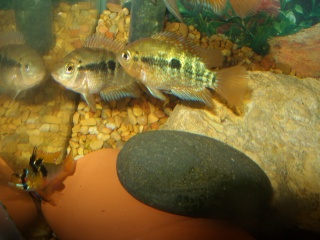The Rainbow Cichlid (H. multispinosa) Name(s):
Name(s): Herotilapia multispinosa
Common Name(s): Rainbow Cichlid
Origin: Central America (Honduras, Costa Rica and Nicaragua).
Family: Cichlidae
Species Type: Multispinosa
Maximum Size: 5" (12.7 cm)
Life Span: 8 years
Natural Habitat: Central American Rivers and swamps with sandy or rocky substrate and moderate water flow.
Diet: Though their diet in the wild mainly consists of algae, captive specimens thrive on prepared flake food as well as a variety of insect based foods, pellets, Cichlid sticks, bloodworms, tubifex worms and small amounts of shrimp. It is important to provide a significant amount of vegetable matter in their diet. Peas, cucumbers and Spirulina are sufficient staples of a varied diet, and are often eagerly consumed.
FYI: H. multispinosa is unique in that it possesses tricuspid teeth, which greatly enhances the ability to feed on filamentous algae, making up a large portion of its natural diet. These three specialized teeth have earned multispinosa its own genus, Herotilapia.
Temperature: 71 F to 78 F (22 to 26°C)
PH: 7.0 - 8.0 is ideal, but H. multispinosa can tolerate many types of water conditions. Avoid poor water conditions by performing weekly water changes of at least 20%.
Minimum Tank Size: 20 gallons (76 liters)
Tank Region: Everywhere.
Temperament: Peaceful, but become very territorial when breeding.
Possible Tank Mates: H. multispinosa is a community Cichlid. In a community Cichlid tank of larger semi-aggressive Cichlids. The Firemouth Cichlid, Blood Parrot, and Convict Cichlid can make good tank mates due to their non-competitive nature, but be sure to keep an eye on them and make sure everyone's doing okay. They can also be kept in a tropical tank with catfish, certain live bearers, tetras, and plecostomus.
They can readily be kept singly or in pairs. Being relatively peaceful, if the tank is large enough they may even be housed with another pair. Like all Cichlids these fish do become territorial during spawning.
Filtration and Setup: H. multispinosa prefers a moderate water flow with a fine substrate and heavy cover. Provide plenty of rocky caves to use as hiding places with ample open areas for swimming as well. Males will not tolerate other males in a small space, especially during breeding. If keeping more than one pair, provide at least 4' of tank length, with enough caves for each fish. They will peacefully coexist with tank mates as long as there is plenty of living space.
Coloration: H. multispinosa is capable of altering colors according to its moods. With its characteristic golden coloration along with the orange eyes, black markings, and subtle blue hues it is a truly stunning addition to any aquarium.


 Sexing:
Sexing: Males will be slightly larger, have more coloration, the dorsal, anal and tail fins extend
to a point.
Breeding: Allow pairs to form naturally from a group of six if possible. H. multispinosa are mature and ready for spawning at a size of just 3". To condition for spawning, raise the temperature to 82 degrees and generously feed a quality flake food high in vegetable content. Many times, spawning can be predicted by a change of colors. Deeper orange accompanied by black along the lower body portion is usually a sure sign of reproductive activity. H. multispinosa are easy breeders, and will defend their fry even in a community tank. Eggs are laid on a flat area of rock or other surface, and are cared for by both the male and female. Parents will take turns fanning the eggs and warding off predators, and will continue to care for fry once they become free swimming. The eggs will hatch in about 5 days and tiny fry will be free swimming with in 9 days. Once free-swimming, fry may be fed micro worms and baby brine shrimp for the first few weeks, and will also pick at microscopic flora and fauna present on surfaces in the tank. Growth is relatively well paced. The fry grow out to about 1 inch in 2 months.







